City of Dawson Creek hosts CMHC Sustainability Workshop

Sustainable development is a global concern. It is easy to picture, on a large scale, how human civilization affects the availability of natural resources and the condition of our planet's environment. According to Dawson Creek Mayor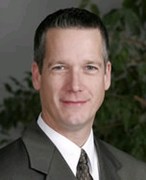 Calvin Kruk, “In small communities, the need for sustainable development is sometimes less apparent – but the pressures are every bit as real. That's why it is also important to adopt sustainable planning and development practices. And it is why we are so pleased that the Canada Mortgage & Housing Corporation (CMHC) has developed a workshop program that is designed specifically for municipal decision makers.” Below, Mayor Kruk makes his opening remarks.
Calvin Kruk, “In small communities, the need for sustainable development is sometimes less apparent – but the pressures are every bit as real. That's why it is also important to adopt sustainable planning and development practices. And it is why we are so pleased that the Canada Mortgage & Housing Corporation (CMHC) has developed a workshop program that is designed specifically for municipal decision makers.” Below, Mayor Kruk makes his opening remarks.

The Dawson Creek workshop was attended by over 30 people and included representation from the City of Dawson Creek, Town of Fort St. John, Village of Chetwynd, Village of Pouce Coupe, Peace River Regional District, Peace River School District and the Ministry of Transportation. For a description of the workshop program, please click on this link to Sustainable Planning and Development for Small Communities – Workshop Overview
The Audience
“The audience was diverse and represented a broad cross-section of the region,” observed Lance Jakubec of CMHC, “We had elected officials from the four 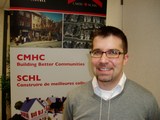 municipalities. In addition, we had municipal staff and community representatives such as the Dawson Creek Senior Citizens Association, Dawson Creek Chamber of Commerce, Northeast Environmental Action Team, and Dawson Creek Beautification Committee.” Jakubec was the leader of a 4-person presentation team that also comprised Allan Dobie (an architect with CMHC), Luc Delestrade (Lighthouse Sustainable Building Centre) and Kim Stephens (Program Coordinator, Water Sustainability Action Plan for British Columbia).
municipalities. In addition, we had municipal staff and community representatives such as the Dawson Creek Senior Citizens Association, Dawson Creek Chamber of Commerce, Northeast Environmental Action Team, and Dawson Creek Beautification Committee.” Jakubec was the leader of a 4-person presentation team that also comprised Allan Dobie (an architect with CMHC), Luc Delestrade (Lighthouse Sustainable Building Centre) and Kim Stephens (Program Coordinator, Water Sustainability Action Plan for British Columbia).

“It was a fun day,” added Allan Dobie, “We typically do four or five workshops of this type every year, and this was by far the best in terms of audience response and appreciation.” Below, Allan Dobie explains emerging trends in energy management to an attentive audience.

The Presentations
 There were three presentation segments in the morning session. First, LANCE JAKUBEC opened the workshop with a presentation on Sustainable Planning and Development for Small Communities – An Overview A community planner with experience both with local government and the private sector before joining CMHC, Lance addressed the question 'what is sustainable development' to provide participants with a 'mind map' for the workshop.
There were three presentation segments in the morning session. First, LANCE JAKUBEC opened the workshop with a presentation on Sustainable Planning and Development for Small Communities – An Overview A community planner with experience both with local government and the private sector before joining CMHC, Lance addressed the question 'what is sustainable development' to provide participants with a 'mind map' for the workshop.
Lance was followed by ALLAN DOBIE, an architect who worked for 30 years in the private sector prior to joining CMHC six years ago. To download his presentation, 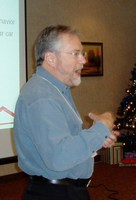 click on this link to Sustainable Planning and Development for Small Communities – Transportation and Energy . A reference to Wal-Mart on the topic of downtown development triggered a lively discussion. Interestingly, the City of Dawson Creek has observed that its new Wal-Mart store is attracting shoppers from other Peace River communities. In short, this is resulting in a net benefit to Dawson Creek. As one participant observed: “If Wal-Mart had located in another municipality, Dawson Creek shoppers would be going there, resulting in a net loss to the City.”
click on this link to Sustainable Planning and Development for Small Communities – Transportation and Energy . A reference to Wal-Mart on the topic of downtown development triggered a lively discussion. Interestingly, the City of Dawson Creek has observed that its new Wal-Mart store is attracting shoppers from other Peace River communities. In short, this is resulting in a net benefit to Dawson Creek. As one participant observed: “If Wal-Mart had located in another municipality, Dawson Creek shoppers would be going there, resulting in a net loss to the City.”
LUC DELESTRADE, an energy modeller with the Light House Sustainable Building Centre, then made a presention titled Municipalites: Future Sustainability Leaders Light House is an enterprising non-profit society 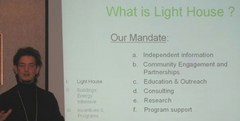 staffed by experienced and passionate building professionals. Luc informed the Dawson Creek audience that “our mission is to advocate for and catalyze the sustainable bulding sector in British Columbia. Our centre is the place to find out about sustainable building practicies, policies, and projects and to connect with the experts that can help you make your next project greener and healthier.” Funding partners for Lighthouse include CMHC, VanCity, the Real Estate Foundation of BC, Environment Canada, EcoTrust, City of Vancouver, BC Hydro PowerSmart, and Western Economic Diversification Canada.
staffed by experienced and passionate building professionals. Luc informed the Dawson Creek audience that “our mission is to advocate for and catalyze the sustainable bulding sector in British Columbia. Our centre is the place to find out about sustainable building practicies, policies, and projects and to connect with the experts that can help you make your next project greener and healthier.” Funding partners for Lighthouse include CMHC, VanCity, the Real Estate Foundation of BC, Environment Canada, EcoTrust, City of Vancouver, BC Hydro PowerSmart, and Western Economic Diversification Canada.
In the afternoon session, Allan Dobie led off and provided an overview on water, wastewater and stormwater by drawing on case study examples from across Canada: Sustainable Planning and Development for Small Communities – Water, Wastewater and Stormwater Systems
Allan was followed by KIM STEPHENS whose presentation was titled Water – Choosing Sustainability for Life and Livelihoods: An Introduction to the Water Sustainability Action Plan for British Columbia. An engineer-planner, Kim has 30- plus years of experience in all facets of water, and has been invited to speak on the British Columbia experience at forums across North America and in Australia. His innovation related to the rainwater management and watercourse protection strategy for the UniverCity Sustainable Community on Burnaby Mountain was featured in the book Dancing with the Tiger: Learning Sustainability Step by Natural Step.
plus years of experience in all facets of water, and has been invited to speak on the British Columbia experience at forums across North America and in Australia. His innovation related to the rainwater management and watercourse protection strategy for the UniverCity Sustainable Community on Burnaby Mountain was featured in the book Dancing with the Tiger: Learning Sustainability Step by Natural Step.
Formerly a Vice-President with CH2M Hill, Stephens has been Program Coordinator for the Water Sustainability Action Plan since 2003. The Action Plan is being delivered by the BC Water & Waste Association through a partnership with the Province. For more on this part of the story, please click here. “One of the perspectives that I bring from my former life with a multi-national corporation is that my experience in traveling to other regions allows me to see British Columbia in context. In my view, British Columbians truly are innovative. There is a lot happening throughout this province, but the word has not been getting out. People have not been telling their stories. One of the Action Plan outcomes is to celebrate the successes that are happening on the ground,” observed Stephens.

MAKING INFORMED DECISIONS: The focus of his presentation was on Convening for Action in British Columbia and what is being accomplished in three regions through partnerships and pilot programs.”The challenge is to make informed choices that will produce cumulative benefits over time, and thereby ensure long-term community vitality and livability,” stated Stephens, “To make an informed decision, one must first be informed. Furthermore, how can one have an informed group discussion if people are not informed. This is why the purpose of the Convening for Action program is to inform and educate. Because the way we develop land determines how water is used and how water runs off the land, we are developing the tools and experience to develop land and use water differently.” One of the tools that Stephens introduced to the Dawson Creek audience was the Water Balance Model for British Columbia. For more information, please download his presentation via the link provided above.
benefits over time, and thereby ensure long-term community vitality and livability,” stated Stephens, “To make an informed decision, one must first be informed. Furthermore, how can one have an informed group discussion if people are not informed. This is why the purpose of the Convening for Action program is to inform and educate. Because the way we develop land determines how water is used and how water runs off the land, we are developing the tools and experience to develop land and use water differently.” One of the tools that Stephens introduced to the Dawson Creek audience was the Water Balance Model for British Columbia. For more information, please download his presentation via the link provided above.
Lance Jakubec rounded out the afternoon with a presentation titled Sustainable Planning and Development for Small Communities – Housing, Land Use Policies and Regulatory Tools
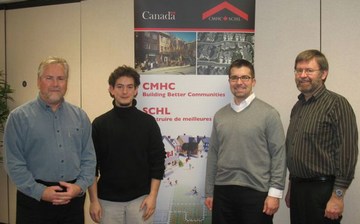
Posted December 2006

